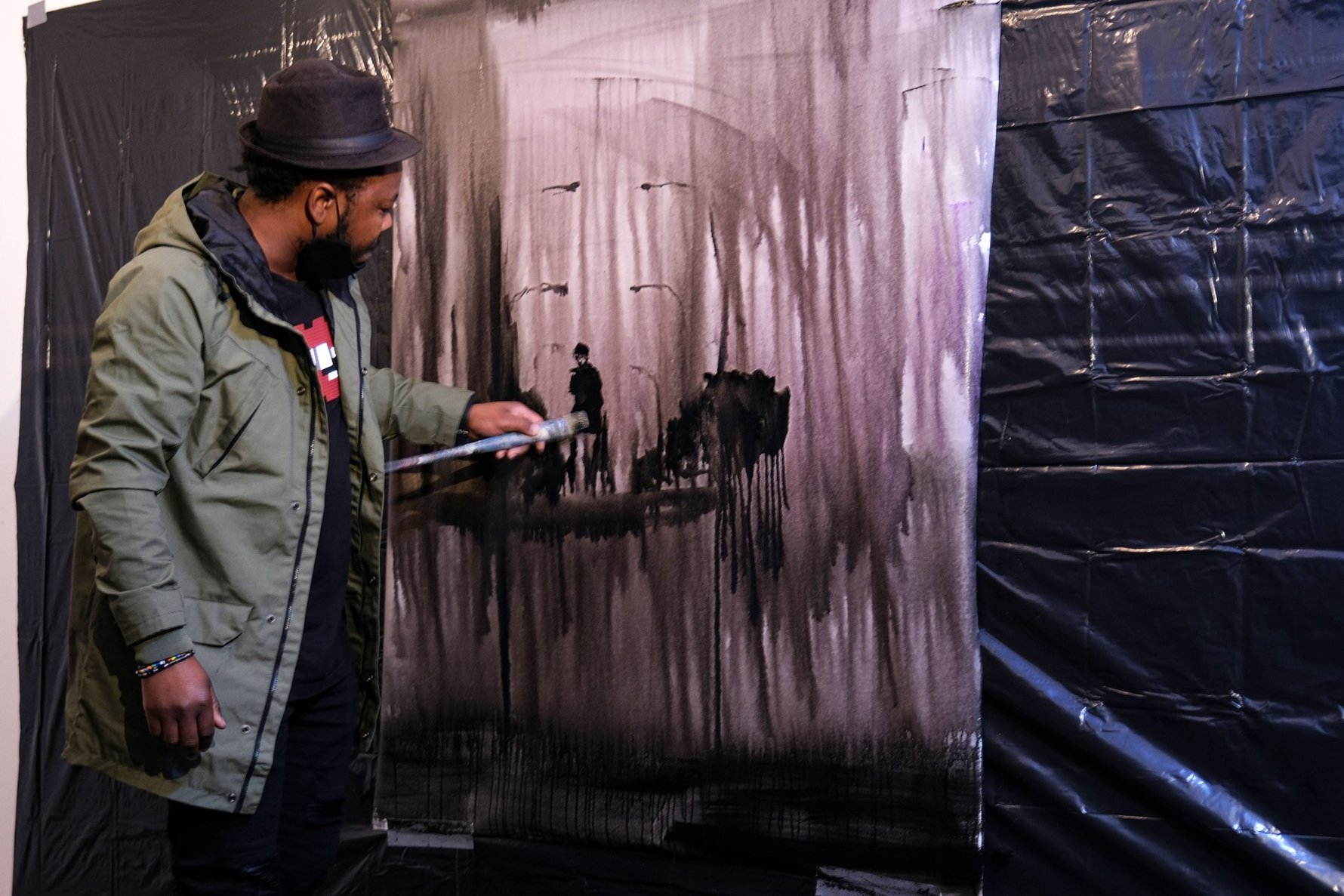
Lehobye was born in Soweto and grew up between Evaton, Vaal and Orange Farm before moving to Joburg permanently. As a teen, trips to Artist Proof Studio and the Afrika Cultural Centre made him aware of what was possible within the realm of art – the beginnings of his love affair with the city. Nowadays, when he isn't fulfilling his role as head of design at brand agency FCB, Lehobye spends much of his time in deep engagement with Joburg: wandering the city's streets at sunset or documenting these moments in paint and charcoal. These mediums come together to communicate both the irresistible allure of Johannesburg as well as its sharper edges, seen thoughtfully through the lens of an artist who truly loves this place.
We caught up with Lehobye to find out more about his personal story, the works in Rite of Passage and his life in Joburg today.
Your artworks lovingly portray Johannesburg in all its grit and glory. Tell us about your relationship with this place and why it is such an enduring source of inspiration for you.
My deep connection to Johannesburg has been a cornerstone of my artistic journey, serving as a constant source of inspiration for my creative work. I was born in Soweto and raised in various communities in the Vaal region. My mother would take me to Joburg once each festive [season] for Christmas shopping, and I would always look forward to these experiences. These trips made me even more fascinated by the city. They gave me a glimpse of the city's complex and vibrant character. My journey into the world of art began early on. As a child, I found solace and pure joy in drawing and constructing miniature towns with whatever objects I could find. Art became a way of escaping; a place where I felt in control and free from judgement. It was a source of immense personal happiness. This is how I feel about Joburg today. It was when I started exploring Johannesburg as a young artist that my relationship with the city truly deepened. Those trips into the city, especially my visits to the Artist Proof Studio and the Afrika Cultural Centre, opened my eyes to a broader world of artistic possibilities. I began experimenting with painting and, in the process, fell head over heels for Johannesburg. To me, it represented "the bigger world"; a place bursting with creativity and endless opportunities.
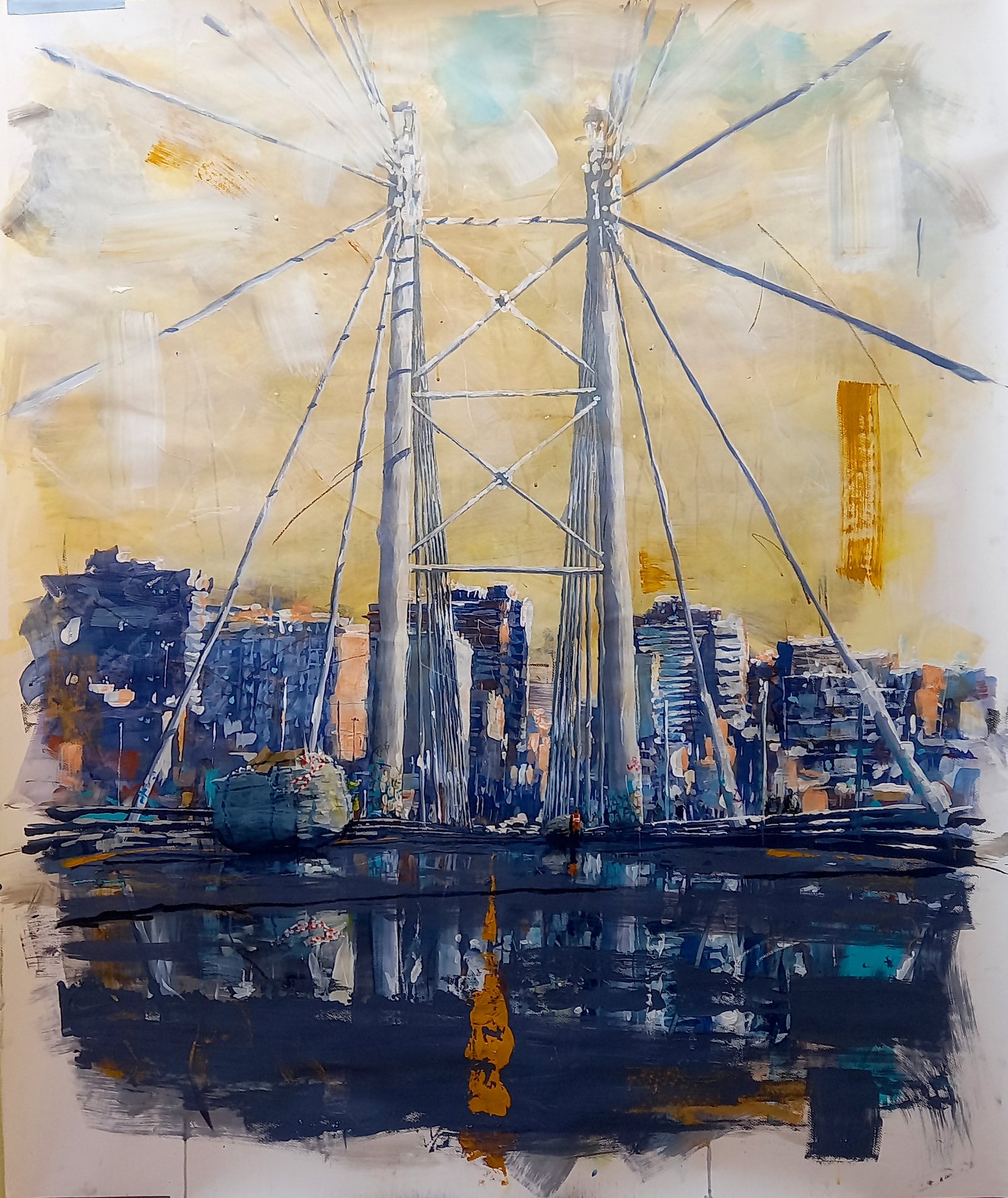
"Living in Johannesburg has been a transformative journey that has shaped both my life and my art. This city, with its relentless pace and diverse tapestry of experiences, has instilled in me resilience, determination and an unwavering pursuit of my dreams."
As the title of your latest exhibition suggests, living in Joburg is a rite of passage for dreamers and doers striving to make their mark. What did this initiation entail for you personally when you decided to make Joburg your home?
For me, Johannesburg represents a school of hard knocks. It's a place where I've learnt invaluable life lessons, some of which I hold dear. It's a city of contrasts, where I've experienced the highs of falling in love and the lows of heartbreak. It's a populous city, but it can also feel like the loneliest place at times, reminding me of the need for resilience and self-reliance. This city demands respect, and I've had my share of challenges and setbacks here. I've faced moments of adversity that felt as if the Hillbrow Tower was showing me a defiant middle finger. But through it all, Johannesburg has been my muse and my inspiration, a place that continually pushes me to explore its complexities and tell its stories through my art.
How has the city transformed you?
Living in Johannesburg has been a transformative journey that has shaped both my life and my art. This city, with its relentless pace and diverse tapestry of experiences, has instilled in me resilience, determination and an unwavering pursuit of my dreams. It's a place where I've learnt the value of adaptability and the power of reinvention, just like the ever-evolving urban landscape it embodies. Johannesburg's complexities have taught me life's most valuable lessons, from the highest highs to the lowest lows, and through it all, I've emerged as an artist and an individual with a profound appreciation for the enduring spirit of this remarkable city.
What does home mean to you?
Home is not merely a physical place but a profound sense of belonging and familiarity. Home is where I've found comfort and solace, where I made lasting memories and relationships. It's a place where I've learnt about resilience and the value of embracing challenges. Just as Johannesburg has been a transformative experience, home represents a sanctuary where I can reflect on my journey, draw inspiration and continue to evolve as an artist and an individual. It's a space that holds the echoes of my past and the promise of my future, a place where I can make my mark while cherishing the memories and experiences that have shaped me.
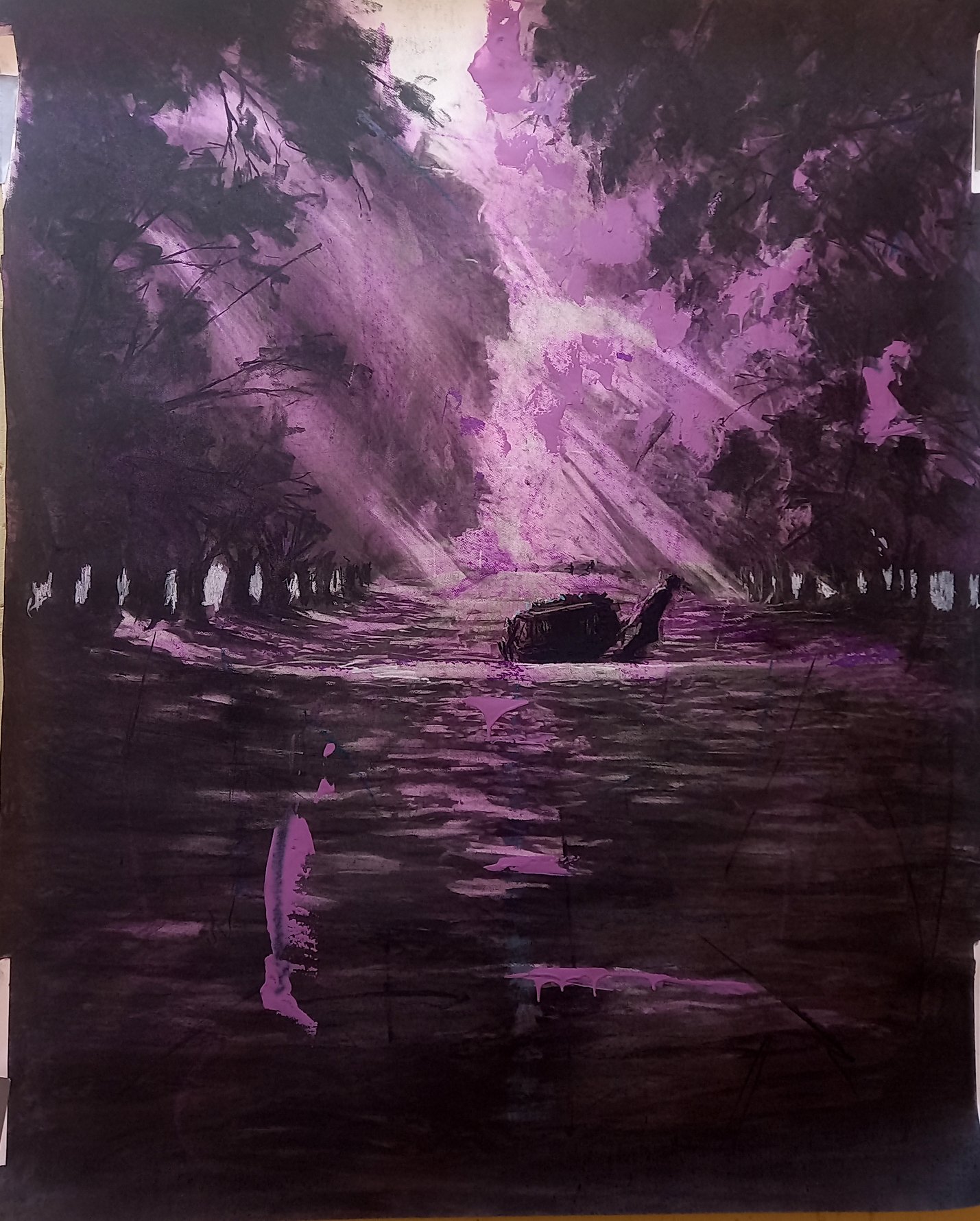
What were some of your first impressions of life in Joburg?
My initial impressions of life in Johannesburg were a blend of awe and challenge. The city had this captivating aura, romanticised by its reputation as a place where dreams could be realised. Its bustling streets, diverse cultures and vibrant energy gave me a sense of excitement and endless possibilities. However, I soon realised that beneath the romanticised façade lay a city that could be tough and unforgiving. It was a place where the highs were exhilarating, but the lows were equally stark and humbling. Johannesburg taught me not only to romanticise its potential but also to appreciate its complexity, acknowledging that it's a city of contrasts where both dreams and challenges coexist in a delicate balance.
Do those initial impressions hold true today, or how have they changed?
My initial impressions of Johannesburg portrayed it as a mirage of boundless possibilities, an alluring vision that beckoned with the promise of success. However, I've come to realise that the reality is what we make it. While the city's initial allure remains, I've learnt that it requires hard work and resilience to turn its potential into a tangible reality. Johannesburg still embodies a place of dreams, but my journey here has deepened my appreciation for its complexities and reinforced the notion that we must be dedicated to shaping our own destiny to make those initial impressions a lasting truth.
You began visiting Artist Proof Studio [then located in Newtown] in high school. Tell us about this pivotal point on your art map and how it laid the foundations for your practice.
Visiting the Artist Proof Studio during high school was an absolutely pivotal point on my artistic journey, setting the foundations for my practice in profound ways. It marked the beginning of my formal artistic education and introduced me to a world of creativity that went far beyond my childhood experiments with drawing. Perhaps the most significant aspect of my time at the Artist Proof Studio was the opportunity to learn from accomplished artists and educators. Kim Berman, Nhlanhla Xaba, Lucas Nkgweng, Stompie Selebi and others imparted their knowledge and insights, exposing me to the work of renowned artists like Dumile Feni and Gerard Sekoto. Being in the presence of these creative luminaries inspired and instilled in me a belief that greatness was attainable and that I could contribute to the world of art. In essence, Artist Proof Studio provided me with the formal training, mentorship and exposure to the broader art world that laid the solid foundations for my artistic practice. It was a place of learning, growth and inspiration, shaping my perspective and nurturing my artistic talent.

When you think of Johannesburg as a city for art and artists in particular, what comes to mind?
When I think of Johannesburg as a city for art and artists, the resilience and creative spirit exemplified by Artist Proof Studio's experience of rebuilding after a fire comes to mind. Johannesburg, like this studio, embodies the idea that out of chaos and destruction can emerge beautiful things, and from ashes can rise new beginnings. The city itself is a vibrant and complex canvas, rich in diversity, history and culture. It has been a source of inspiration for countless artists, both native and those drawn from around the world. Johannesburg's dynamic energy, ever-evolving urban landscape and the tenacity of its people have contributed to a thriving artistic community. Much like Artist Proof Studio's ability to renew and reinvent itself, Johannesburg provides a platform for artists to explore and push boundaries, to experiment and create. It's a city that challenges artists to see beyond the surface and delve into its complexities, finding beauty in unexpected places and stories. Johannesburg, as a city for art and artists, embodies the notion that creativity can flourish in the face of adversity. It encourages artists to draw inspiration from the city's contrasts and contradictions, to transform challenges into opportunities and to contribute to the ever-evolving narrative of a place where dreams are both forged and fulfilled.
Labyrinth is the title of one of your works in Rite of Passage. Any advice for those seeking to navigate this maze?
In the midst of life's challenges and complexities, remember to find beauty in the journey itself. Much like the art that emerges from the creative process, cherish the experiences and moments that shape your path. This can be seen in the ideas of the Impressionists and how they approached the work and life itself. Capturing moments in time.
What made you choose paint and charcoal as your medium?
I chose paint and charcoal as my media because they enable me to incorporate the diverse textures of the city into my artwork. With paint, I can capture the city's dynamic atmosphere through layering and blending, while charcoal allows me to convey the gritty, spontaneous nature of urban life. These together help me translate the city's essence into a tangible and evocative form of artistic expression.
"Johannesburg taught me not only to romanticise its potential but also to appreciate its complexity, acknowledging that it's a city of contrasts where both dreams and challenges coexist in a delicate balance."
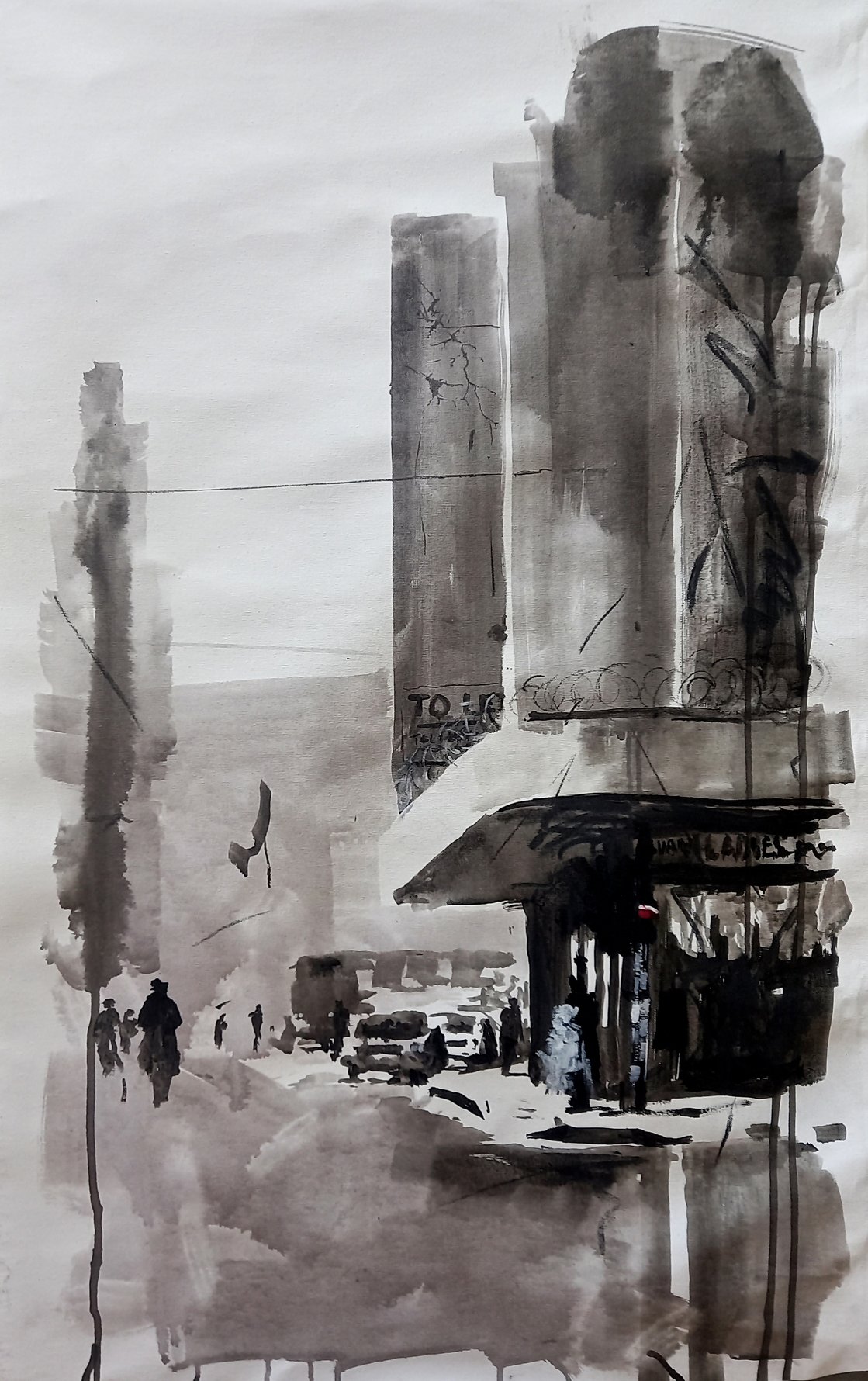
You engage with Joburg through your art. What has that taught you about the city and the people who live in it?
My work, at first glance, might appear as a form of documentation, merely recording the physical state of a place. However, my intention goes beyond that; it's about capturing the essence of my personal experience within that place. I strive to convey this emotional connection by amplifying mood through the careful use of texture and colour. In this process, I've come to realise that we all share a common narrative when it comes to our relationship with the city. Our story resembles that of a miner, someone who embarks on a journey from far and wide in search of something precious, something more profound than a physical commodity like gold. This quest gives our lives purpose and meaning, making the journey itself incredibly valuable. To symbolise this deep yearning, I incorporate gold in a metaphorical sense within my art, emphasising the significance of this ongoing pursuit. Through this exploration, I've learnt valuable lessons in empathy and tolerance. Regardless of our origins, we're all drawn to this city by our own quests for "gold". It may not always be gold in the literal sense, but we're all on a journey in pursuit of something meaningful. This realisation has deepened my understanding of the shared human experience and brought to light the notion that what one person may discard as worthless can hold immense value for another. This concept is particularly evident in my artwork featuring "reclaimers" and their trolleys, symbolising the beauty of finding treasure in unexpected places.
"My journey into the world of art began early on. As a child, I found solace and pure joy in drawing and constructing miniature towns with whatever objects I could find. Art became a way of escaping; a place where I felt in control and free from judgement. It was a source of immense personal happiness. This is how I feel about Joburg today."
Tell us about your other life as head of design at [brand agency] FCB. What makes Joburg a great place to be doing this work?
My role as the head of design at FCB has been an enriching and dynamic aspect of my life. Johannesburg, as the backdrop for this work, offers a unique and vibrant environment that greatly enhances the creative process. What makes Joburg a fantastic place for my role at FCB are several key elements: Johannesburg is a hub for creativity, with a thriving creative community that's both diverse and dynamic. Working in this city means being surrounded by talented individuals who bring a wealth of ideas and perspectives to the table. The people I've had the pleasure of collaborating with at FCB have been nothing short of amazing, and I've built lasting friendships along the way. It's a city where creativity knows no bounds, and that energy infuses our work at FCB. The city is a melting pot of cultures, traditions and experiences. This cultural richness provides a deep well of inspiration for our design work. We draw from the city's tapestry of stories, people and histories to create designs that resonate with a diverse audience. Art and design in Johannesburg are not just about aesthetics; they're a reflection of the city's soul, and that authenticity adds depth and resonance to our creative endeavours. Joburg's unique blend of creativity, cultural richness and opportunity makes it an ideal setting for my work. It's a city that continually inspires and challenges us to create work that not only looks great but also connects with people on a profound level, ultimately contributing to the success and enduring relevance of South Africa's most loved brands in a meaningful way.
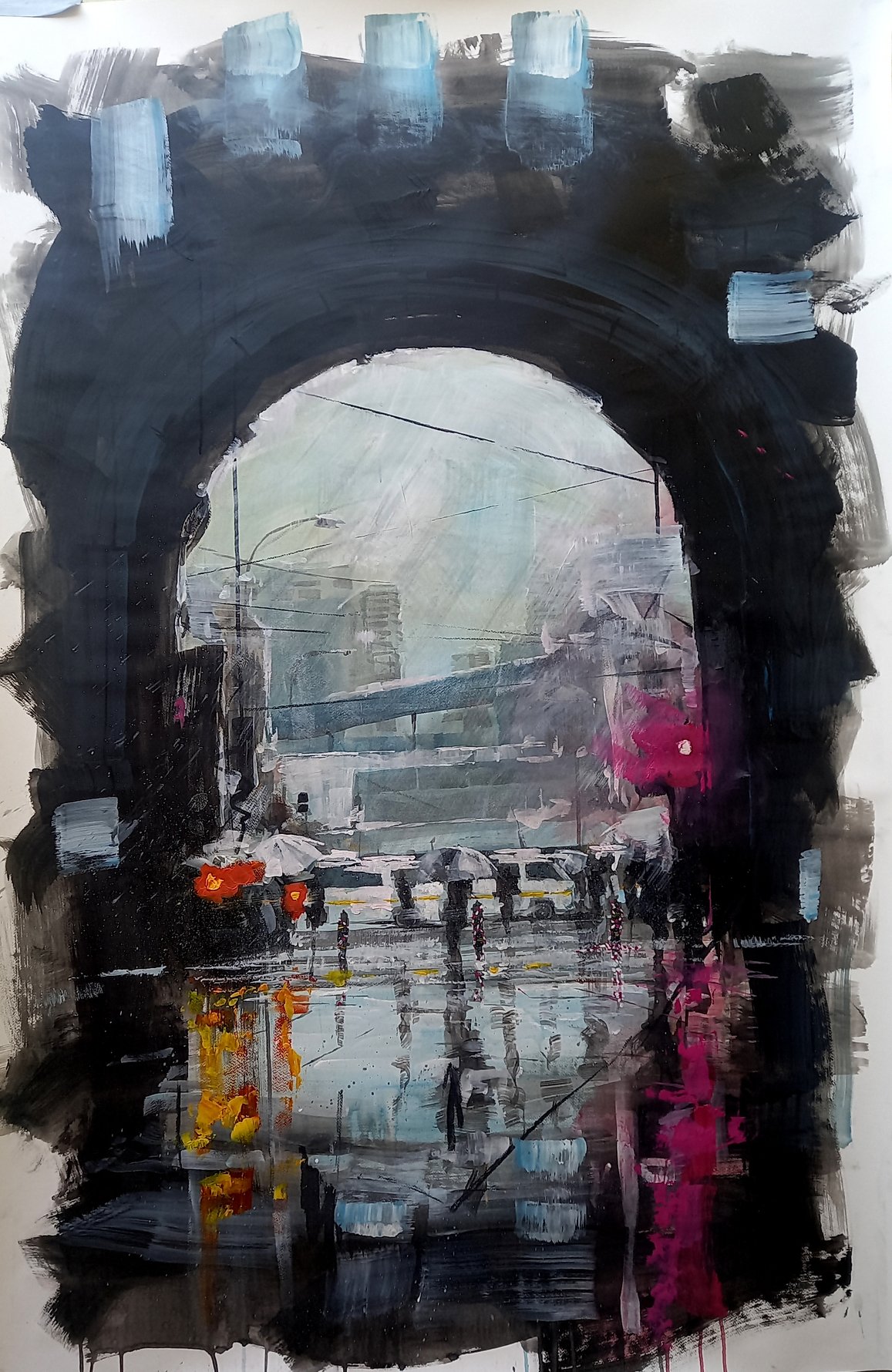
How do you manage to be both an artist and hold a senior role at an agency?
My journey took an intriguing turn during the pandemic, sparking a reawakening within me. I believe there are many of us who underwent a similar experience during those times. It's a phenomenon we ought to define with a term of its own, for it marked a pivotal shift in how we perceive the balance between work and leisure. It was during this period that I reclaimed my brushes and reignited my passion for painting. Having the role of a design lead demands considerable mental engagement, and painting serves as my creative outlet. I discovered that when I can strike a harmonious balance between the two, both aspects of my life flourish. This equilibrium is of utmost importance to me, not only for my artistic well-being but also because it helps keep my medical bills low.
Where do you go in the city when you need to be energised, nourished, refreshed or inspired?
I often stroll along Marshall Street [in the City Centre] on Sundays, and I'm consistently amazed by how soothing those walks can be. I find that capturing most of my images on Sundays sets the perfect mood and puts me in a positive state of mind.
If you could only paint one Johannesburg scene?
There are numerous memorable experiences. Taking leisurely walks amidst the hustle and bustle of Eloff Street, unwinding in Joubert Park and finding tranquillity in the Joburg Theatre gardens while gazing down Jorrisen Street as the sun begins to set – these are just a few. However, one experience that truly stands out for me is the view of Commissioner Street from Maboneng.
"Johannesburg's dynamic energy, ever-evolving urban landscape and the tenacity of its people have contributed to a thriving artistic community."

Your favourite Joburg suburb, and why you choose it?
I have some amazing memories while living in a small cottage in Parkhurst. My romanticised bohemian lifestyle was fun, this was also a point when things got rough for me. It is an amazing community of people.
What three things should a visitor not leave Joburg without seeing or experiencing?
A walk in the streets of Joburg (especially the ones I mentioned), a sunset on any one of the rooftops with the great company of a friend on a Sunday, a sunrise walk through the jacarandas in bloom.
The most memorable meal you have eaten in Joburg?
It was a while back on a cold winter's day. I had just taken a few snaps at the old Potato Sheds (Afrika Cultural Centre) that is now Newtown Junction. I popped into the legendary Gramadoelas [restaurant] and had traditional Mogodu [tripe]. They cooked it just the perfect way. The dish sent me home back to my momma.
If you could buy one Joburg building which would it be?
There are a few, but I love the Standard Bank Building. And I really, really love the Barbican [a 10-storey building in the City Centre that's over 80 years old].
If you were the Joburg mayor for one day (average tenure) what would you change?
I believe that there's a need for change in how the city addresses housing, heritage preservation and investment. I see substantial potential in fostering low-cost housing through collaborative efforts between the public and private sectors. We can draw valuable lessons from a few areas that have already excelled in this regard, and these successful models should be replicated citywide. Furthermore, there is untapped potential in terms of heritage preservation. Unfortunately, it appears that the city hasn't fully grasped the significance of restoring and preserving our heritage.

Favourite Joburg label, and why?
[South African streetwear brand] Magents is undeniably a brand that embodies the essence of Johannesburg. Perhaps it's because of their distinctive launch strategy, where they covered walls and underpasses with guerrilla-style tags, reminiscent of the ubiquitous "Tapz." Their bold and widespread presence resonated deeply with me, making them a quintessentially Joburg brand in my opinion.
What makes someone a Joburger?
The miner's state of mind. The one I spoke about earlier.
What do you least like about Joburg?
Governance, or lack thereof.
Is there a particular dish that sums up the taste of Joburg for you?
Good old braai.
The perfect weekend in Joburg includes...
Golden sunsets.
Three words that describe this city?
Resilient, vibrant, diverse.
Rite of Passage runs until Thu, Oct 26 at The Firestation, 16 Baker Street, Rosebank. The Firestation is open daily from 11:00 – 13:00. The exhibition is displayed in the lobby of the building.


_m.jpg)
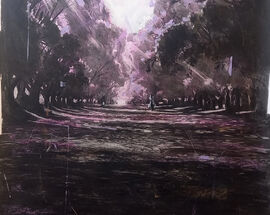
 26-09-2023 (4)_m.jpg)


Comments